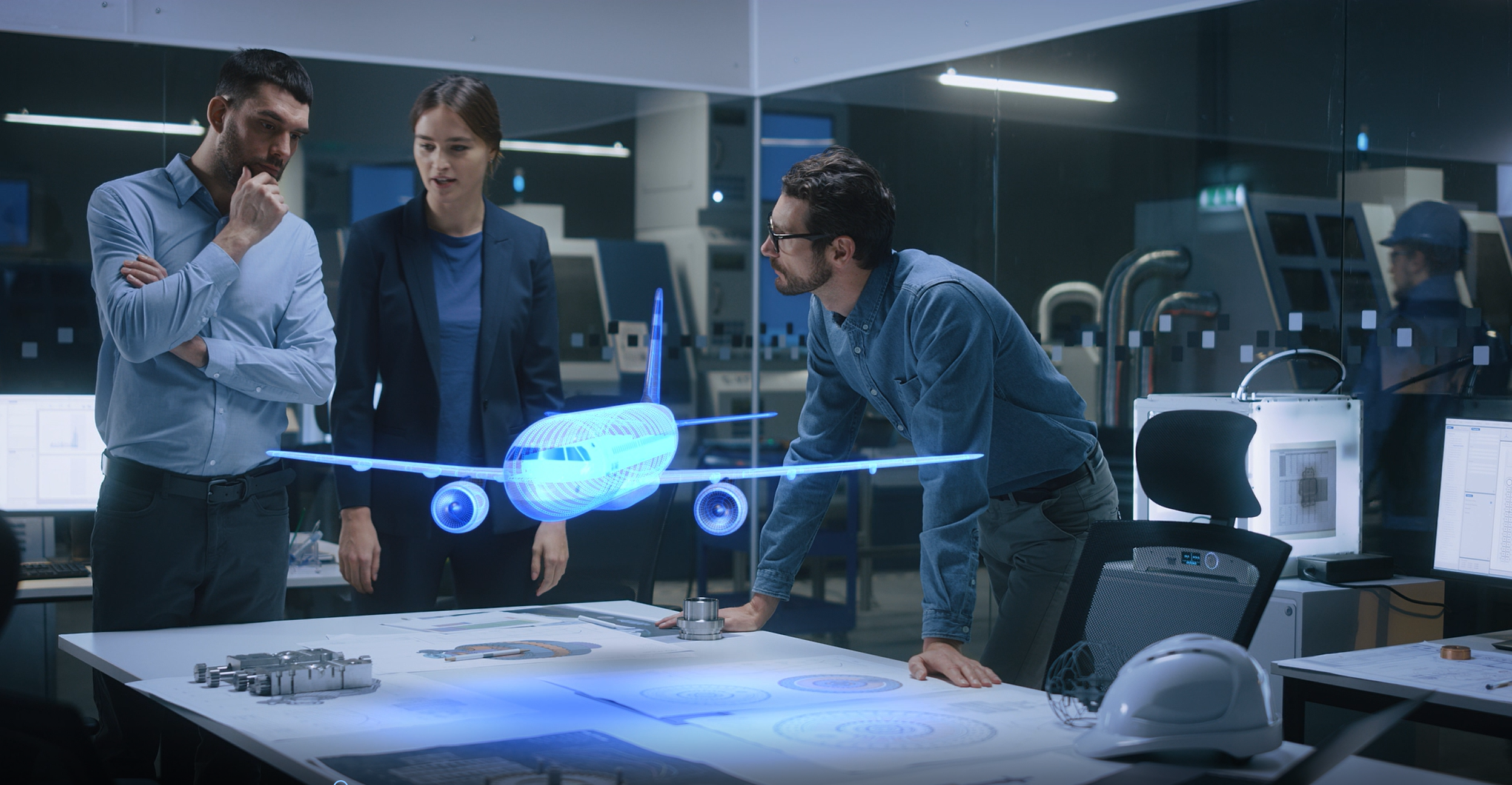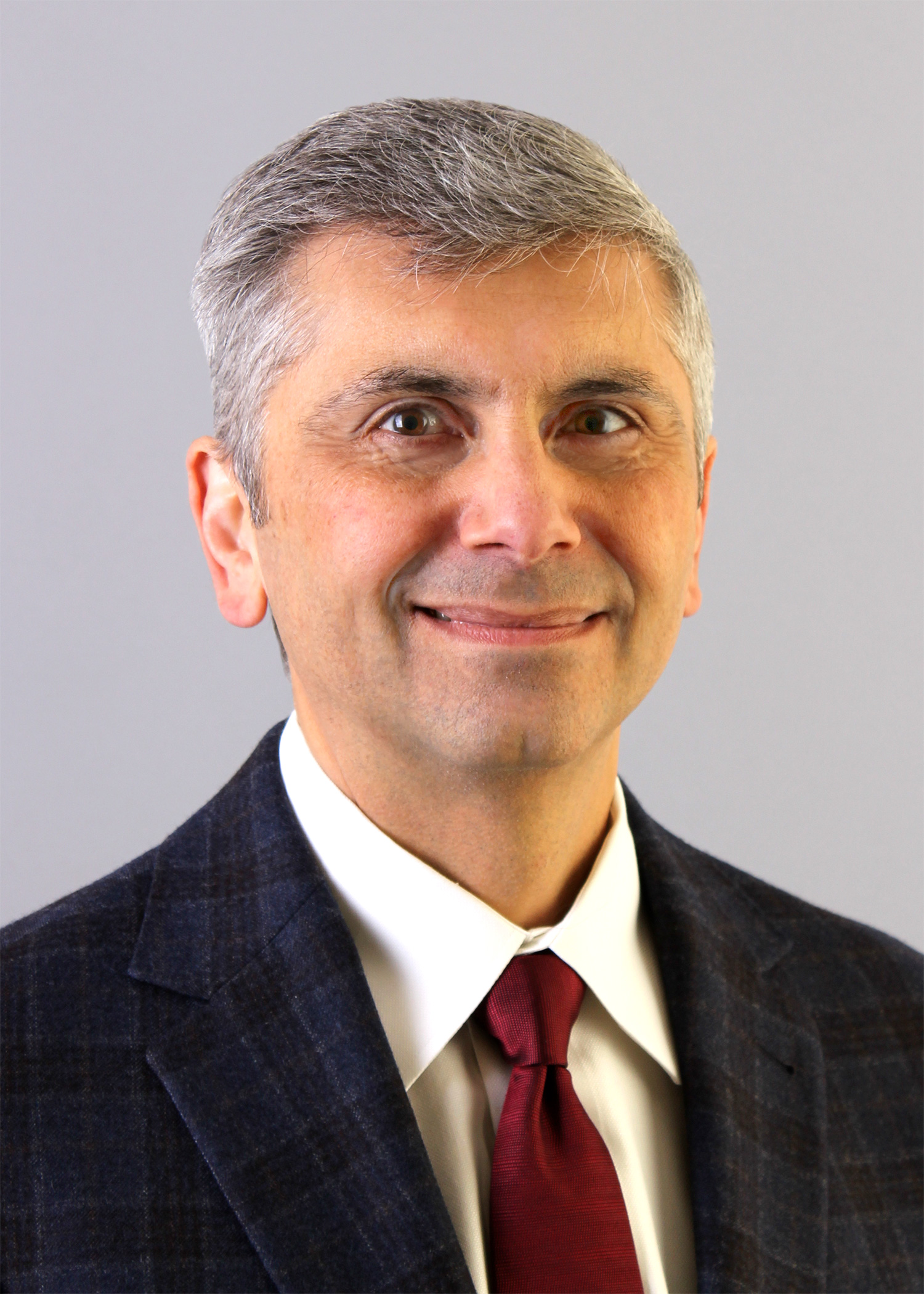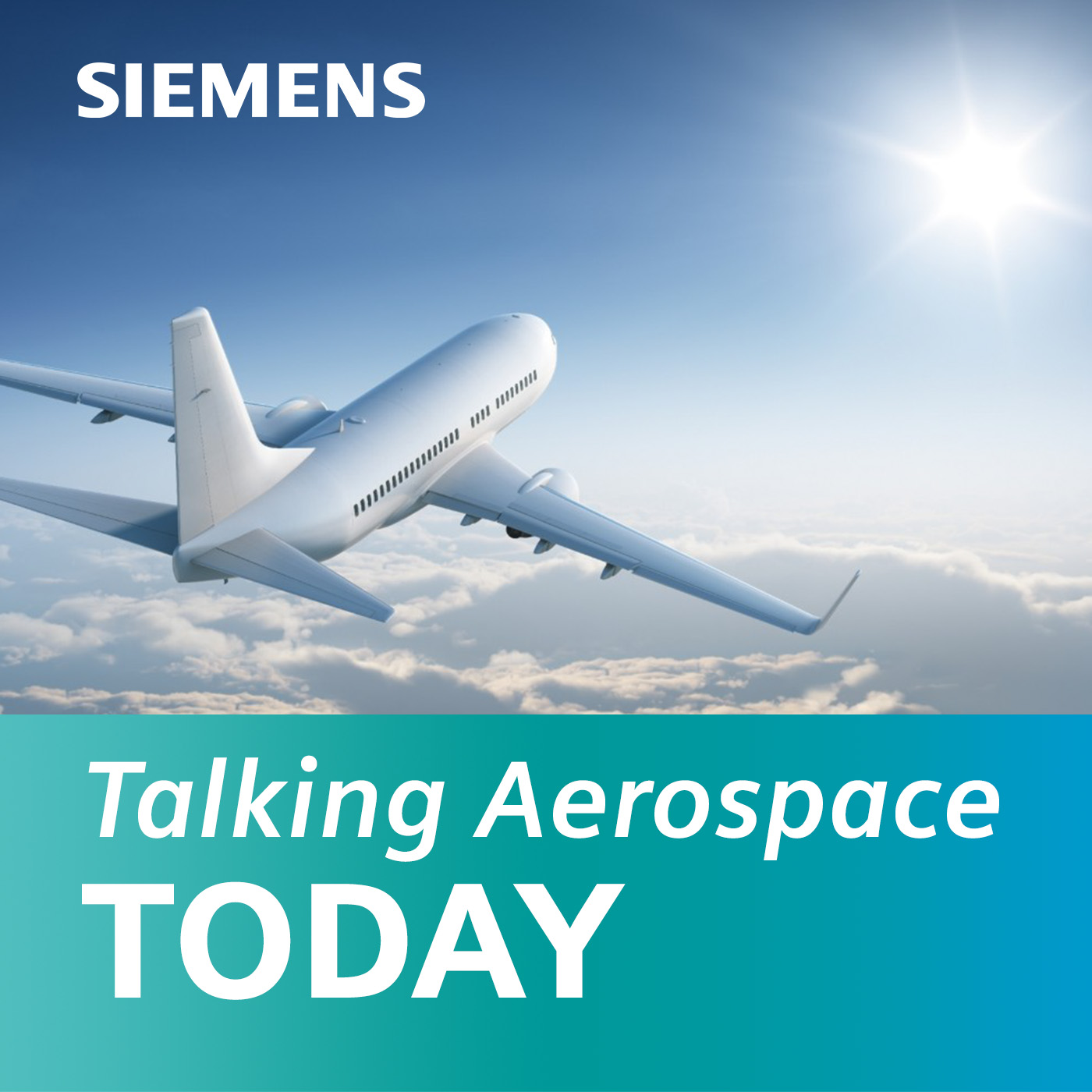New Siemens Electrical Systems podcast series: “The Evolution of Electrical Design in Aerospace”

Welcome to season three of Talking Aerospace Today. In this new five-part series we’ll be diving into the challenges and complexities of electrical design in aerospace today. We’ll discuss why the digital enterprise is so vitally important in all facets of the program development lifecycle. In our first episode, we touch on the trends shaping electrical platform development.
This is episode #1 of a five-part series.
Welcome to Talking Aerospace Today – a podcast for the Aerospace and Defense industry – the place that brings the promise of tomorrow’s technology to the ears of our listeners today.
We’re in a period of intense innovation these days and in order to survive A&D companies must find rapid solutions to get to market faster ahead of the competition. Companies of all sizes have to be flexible, productive, and efficient in finding new ways to reach their goals – in the face of growing complexity in all facets of product design, development and manufacturing.
In our first episode of the podcast series “The Evolution of Electrical Development in Aerospace” we’ll be discussing trends shaping the industry today. How digitalization can become your new best friend. How a model-based approach to electrical design can be implemented throughout the complete product lifecycle from architecture design to certification, from manufacture to product support and beyond.
My special guest, who will shed light on this topic and all upcoming episodes, is Tony Nicoli. Tony is the Aerospace & Defense Director of Integrated Electrical Systems for Siemens Digital Industries Software. Before Siemens, Tony worked in the industry as a researcher, a system engineer, a program manager, and a business innovator. He worked for Honeywell, Loral, and Lockheed Martin mainly in the areas of the surface-to-air missile countermeasures and ultrasonic imaging. Pretty cool stuff!
My name is Scott Salzwedel and I’m the host of Talking Aerospace Today. I invite to take a listen to our latest podcast series that focuses on digitalization and the evolution of electrical design in the A&D industry.
I hope you’ll join us.
In this episode you will learn:
- How electrical design relates to the A&D industry (3:21)
- The trends the industry is facing today (3:39)
- How growing complexity is impacting the industry (5:32)
- How to transition to a model-based approach (7:24)
- A closer look at the Siemens E/E Systems development environment (9:43)
- Can you explain the E/E Systems approach in a step by step process? (10:50)
- Boeing’s model-based development techniques (12:19)
- Tony’s example of a manufacturing case (13:28)
- How Capital is helping customers during this global pandemic (14:22)
- The power behind a model-based development approach (15:21)
Connect with Tony:
Resources:
- Capital website
- Blog: The Capital E/E Systems development solution. Exactly how has Capital evolved?
- white paper: A closer look: Next generation electrical systems platform development
Podcast transcript:
Scott Salzwedel: Hello, this is Talking Aerospace Today, a podcast for the aerospace and defense industry, a place that brings the promise of tomorrow’s technology to the ears of our listeners today.
I’m your host Scott Salzwedel. Welcome to episode one of our new five-part series “The Evolution of Electrical Design in Aerospace.” We know this is a time of great innovation and transformation for the industry. And when it comes to electrical system design and development, there’s a lot to talk about.
Before we get into our first episode and introduce my guest, Tony Nicoli, who we are so pleased to have, I’d like to take a quick minute to explain the direction the podcast series will take. In the first episode we’ll talk about trends shaping electrical platform development. Episode two touches on the evolution of design tools and practices, traditional approaches compared to new methods use today, where the industry’s been and where it’s going. Episode three goes into how the industry is dealing with change management. When a change happens, how to keep configuration control and how to implement across the organization’s business process. Episode four deals with the challenges of how increased complexity and more integration within an aircraft platform impact compliance and certification. Very important topic folks. And finally, in episode five we’ll get into how to maintain and increase manufacturing profitability during this period of crazy market pressures, tooling, streamlining foam board design and installation will be covered.
Alright, let’s get started with our first episode, I’m pleased to introduce my special guest, Tony Nicoli, who’s the Aerospace and Defense Director of Integrated Electrical Systems (IES) for Siemens Digital Industries Software. Welcome, Tony, thanks for stopping by. Before we dive in, could you please share with our listeners your background and role at Siemens?
Tony Nicoli: Well, thanks for having me here today, Scott. I’ve spent most of the last 35 years in and around the aerospace and defense industry. While I was actually in the industry, I was a researcher, a system engineer, a program manager, and a business innovator. I worked for Honeywell, Loral, and Lockheed Martin mainly in the areas of the surface-to-air missile countermeasures and ultrasonic imaging. After joining Mentor Graphics, and later Siemens I served the industry by marketing and selling development software to market leaders like Boeing, Northrop Grumman, and Honeywell. Today, I have the privilege of representing Siemens’s integrated electrical systems business segment as we apply digital technology to accelerate our customers’ business processes.
Scott: Very good, Tony. That’s an impressive track record. I think we should do a podcast on top-secret service-to-air missile countermeasures. What do you think?
Tony: If you can get it cleared, I can join.
Scott: Oh, a technicality. We’ll do that for another day for sure. Okay, today’s topic, the trends impacting electrical design in aerospace. Now when I say electrical design as it relates to aerospace and defense, I’m talking the full meal deal here, folks. From the high-level architecture schematics, the many disciplines that flow into ECAD and MCAD development, validation, verification, manufacturing – right into first flight into service. That’s a pretty tall order. Can you touch on the trends the industry is dealing with today?
Tony: Sure can Scott. So, I think the basic thing we have to remember is that achieving profitability in aerospace and defense companies really depends on executing our programs in an efficient way. And we’re always working to balance risk and innovation in these programs. And today, we have more demanding missions for our platforms, whether it’s commercial or defense. And increasingly, they need new capabilities to execute these missions and the OEMs need additional capabilities to differentiate the platforms. So they’re moving more and more to implementing those differentiating capabilities with electric functions. And that is really increasing the complexity of the overall aircraft itself.
There’s another trend that’s continuing to rise in the industry and that’s the greater rigor and demands around regulatory compliance. It’s becoming more and more difficult to generate the evidence to actually prove that you are compliant with an increasingly large set of regulations. And then finally, there’s a demographic shift that’s affecting companies in many industries, not just aerospace in defense, but it’s particularly impacting aerospace because aerospace has this bi-modal age distribution, where people in the baby boom are retired or retiring, and tribal knowledge is walking out the door. And the next generation really needs to be brought up to speed. So, all that great information that keeps people’s competitive advantage in play can stay inside the company.
Scott: Wow. So let me ask you, are these trends turning into threats for the industry? I’m sure increased complexity is a very real problem.
Tony: Yeah, complexity is growing beyond what can be handled with traditional development approaches. And what I see is that current processes for dealing with complexity were developed for a world where most of the functionality was implemented mechanically. And this also means pneumatics and hydraulics. And in our industry, we really know how to work around late-breaking problems that arise in the traditional mechanical disciplines without major program iterations. But with electrical front and center now in new capability implementation – and this includes networks and software – there’s a lot more at stake. A problem discovered in the first article integration or transition to production can mean a major development cycle, potentially costing billions of unexpected dollars. And this not only puts the program at risk – meaning its cost and schedule – but also it puts the reputations of the program team at risk, and the reputations of the business unit team. And in the worst case, the viability of the company itself.
Scott: Well, I know the industry is doing a pretty good job of turning some of these threats into opportunities. Do you have any examples you could share?
Tony: Well, what I see is that companies that are taking a model-based approach to the overall product lifecycle, and aggressively redesigning their business processes to make use of digital technology, are mastering this complexity and turning it into a competitive advantage. The OECD did a study that showed that companies in the top 5% of economic performance actually enjoy a 25% advantage in productivity over their competition because of their investments in digitalization. I mean, this is huge. And we see it extensively in A&D, where the companies that have invested in model-based development are running away with the orders.
Scott: Okay, so a model-based approach sounds like the way to go. Well, how do we make this happen?
Tony: Well, we need to move beyond a disconnected and largely manual labor-intensive approach to platform development, the kinds of things that have prevailed in the past. And we need to move to this model-based enterprise that exploits a multidisciplinary digital twin and digital data continuity to revolutionize our ability to experiment and innovate while reducing program risk. Maybe I should define my terms a bit. A digital twin is basically the model of the platform and in this case, the model of the platform’s electrical system. And digital data continuity is implemented using what we call a digital thread, and this provides an ability to take information from early in the program all the way to the end, and then vice versa. So, we need to exploit that digital data continuity, to stop doing routine labor over and over again, and stop introducing errors into areas of the design the manufacturing process, and the service documentation that we’re already fine. Too many times, we find that people do a really good job at perfecting what they have in one stage of the development process only to have it screwed up later, unintentionally, because of having to go from one system to another or a manual re-entry. I mean, if we do this, then we can focus our people on the creative activity that brings value to our customers, our employees, and organizations instead of having to make up for the shortcomings of our outdated processes. We’ve been working on this for over 20 years in electrical. And this year, the Capital electrical and electronic systems development environment has broadened beyond electrical distribution systems, to electrical systems modeling and optimization, electronics software, and networks. And it’s now a comprehensive E/E development solution with direct ties to Siemens Xcelerator portfolio. And this portfolio has tentacles that extend into mechanical, pneumatic, hydraulic, and work in coordination with enterprise PLM, ALM, and systems engineering.
Scott: That E/E system sounds very interesting. Perhaps we can dive into that a little bit more.
Tony: Yeah, sure thing. I think the first thing I’d like to do is describe as the basic flows you know because Capital consumes information from a variety of requirements and system modeling environments it takes this info and it normalizes it to feed the platform electrical system development process. And this begins with the capture of an electrical and electronic system functional model, which not only incorporates all the tasks and roles expected of the electrical system, it also accounts for all the communication between these functions and maps, the relevant systems requirements to them. And these are really are important features of the model to get right early in the electrical system development process since by virtue of the digital thread – that digital data continuity I mentioned – these relationships are going to be preserved throughout the platform lifecycle, including manufacturing and service doc’s and you want that information coherently passed throughout the program lifecycle.
Scott: Perhaps we could go a little bit deeper into this if you could how the actual process of how this might play out maybe step by step.
Tony: So Capital then enables these electrical systems engineers to design and optimize the electrical system architecture, they can explore architectural options to better understand the impact of trade-offs early in the development lifecycle, and they are empowered to pick a better starting point for all the effort that follows. This means that there are fewer unanticipated changes at the architectural level that ripple down through the electrical system design and ultimately result in a change to the harness production and the overall design activity in the other disciplines as well. And then armed with this architecture, Capital extracts the information necessary to implement the electrical system and it intelligently parses this info to feed lifecycle development in four separate but related electrical disciplines. And those are electrical distribution or EWIS, electronics, communications networks, and software. And each one of these disciplines uses this data across the complete development lifecycle, from design through production and finally into operational maintenance.
Scott: Wow. So, it seems so much of this is part of the digital transformation we talk about at Siemens. Of course, it’s too soon to talk about how the Capital E/E systems solution might help our customers. But could you mention a few examples of where model-based engineering has been involved in the digital transformation?
Tony: One that I really like to highlight where Boeing actually took a model-based approach to define and then do the bidding on the T-7A, that’s the Air Force’s new trainer program that was then known as the TX and really, forward acting companies are seeing the benefits of this model-based approach paying off already. So, if you take the case of Boeing, whose partner Saab, worked together on the trainer program, by using model-based development techniques, they were able to go from platform concept to first flight in under three years, Boeing’s chief engineer Pawnee Wald said that they were competing against proven in-production aircraft, so they had to do things differently. And the result was that by applying model-based development techniques, the team was able to build their confidence to the point where they could bid $10 billion below the US Air Force’s expected lifecycle program cost, and this won them the program.
Scott: It’s just amazing how much they can actually gain by using these kinds of techniques.
Tony: So Scott, if you don’t mind, I’d also like to share a manufacturing case I found particularly telling. Would that be okay?
Scott: Oh, of course Tony, please do tell.
Tony: Another customer of ours that’s been applying Capital to their electrical design manufacturing processes, has been able to reduce harness manufacturing time by up to 100 hours per bundle. And that alone represented a cost savings of nearly three and a half percent of the platform’s retail price. And that’s major. There are not very many places where any OEM can take that much cost out of their manufacturing process. And this is a clear example of the power of model-based development to favorably impact harness manufacturing.
Scott: Really good stuff, Tony. You can see how the industry is rising to the challenges we discussed earlier. The one challenge we haven’t mentioned yet and that’s our current global pandemic. Could you mention how Capital is helping out in that regard?
Tony: Yeah, this is exciting. I was surprised to hear one of our customers had spent many years putting in place the ability to actually, essentially, have a private cloud inside their organization right and Capital fully supports it. And when the pandemic hit and lockdown hit and people had to go home, they were able to get people to work in the electrical engineering organization without skipping a beat. I think it was two or three days before they were back up and running again. And so, they were able to continue to produce while everybody else was out.
Scott: That’s a powerful story. So I can’t believe it. But we’ve run out of time. It’s just not fair. It’s just gone so fast. Before we wrap things up, is there anything more you want to share with our listeners?
Tony: Well, I think what I really like to emphasize is the power that this provides an organization to respond and to respond rapidly to the evolving needs of their customer base. It’s very easy to be left behind by the needs of all our customers evolving requirements. And while this stuff is really cool, and it’s really fun, it has real implications for revenue and profitability growth for our industry based on the productivity improvement, the first-time quality improvements, and the ability to accelerate fielding safe and innovative platforms to meet emerging mission scenarios. I wouldn’t want to be the program team that had a bid against the ones using model-based development techniques.
Scott: Alright…. well, that just about does it for this episode. Thank you Tony for your insights and your expert opinion on electrical design and aerospace. And I’m really looking forward to our next episode.
Tony: Absolutely no problem, Scott. Thanks for having me. It was a lot of fun.
Scott: Yes, and we’ll be talking again soon. And of course, I’d like to extend my many thanks to our listeners. I’m glad you tuned in to this podcast. Thank you, listeners.
At the top of the show, I mentioned we’ll be doing a five-part series on “The Evolution of Electrical System Design in Aerospace.” If you enjoyed this episode and you want to dive into other episodes, please check out the links in the podcast description. Be sure to subscribe to Talking Aerospace Today on Apple Podcasts, Spotify or wherever you’re listening right now. That way you won’t miss a single episode. Our next episode will be on the evolution of design tools and practices from drafting tables and triangles to the early days of computer-aided design to where digitalization has taken us today.
My name is Scott Salzwedel and this is Siemens Talking Aerospace Today. I hope you’ll join us again for our next podcast.
Until then… Bye for now…

Tony Nicoli – Guest
Anthony Nicoli is the Aerospace and Defense Director for the Integrated Electrical Systems (IES) segment of Siemens Digital Industries Software. He has spent nearly twenty years in the defense industry, developing electro-optic and electro-acoustic systems and businesses, primarily in the tactical missile countermeasure and underwater imaging domains.

Scott Salzwedel – Host
Scott Salzwedel is senior technical writer and corporate communications writer involved in the Siemens Aerospace & Defense Industry and Siemens Capital. In addition to writer/host of Talking Aerospace Today, Scott is the writer of white papers, articles, blogs, videos and websites at Siemens.

Talking Aerospace Today Podcast
The A&D Industry is at a serious inflection point. Transformation to the digital enterprise has opened up a new era in innovation and technological breakthroughs. However, complexity and compliance continue to hamper the best of efforts.
Join us as we explore how Siemens is turning complexity into a competitive advantage for many of our customers – today and well into tomorrow.


